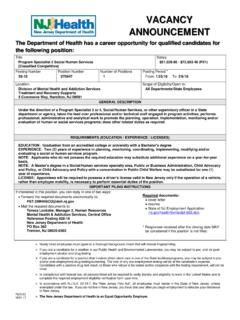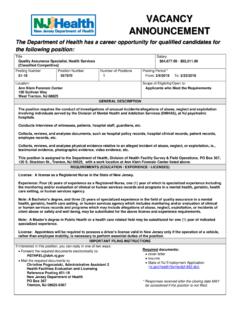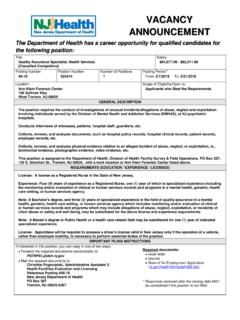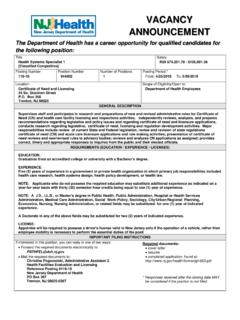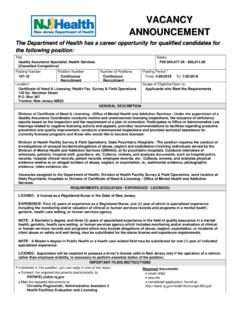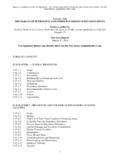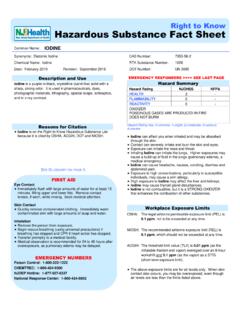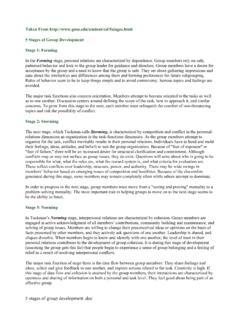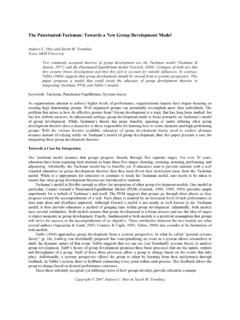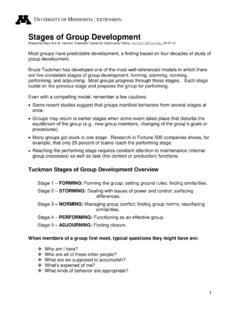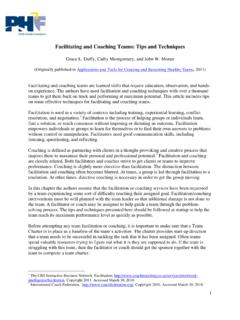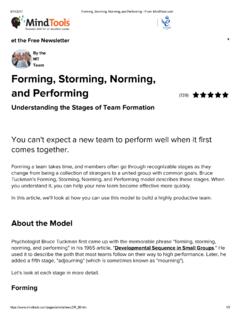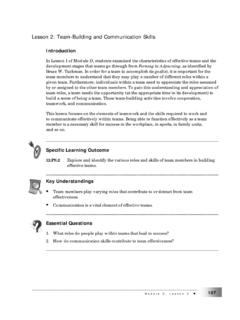Transcription of A GUIDE FOR HELPING GROUPS ET ESULTS
1 FACILITATOR TOOL KIT A GUIDE FOR HELPING GROUPS GET RESULTS OFFICE OF QUALITY IMPROVEMENT Facilitator Tool Kit The facilitator tool kit is a comprehensive, easy-to-use GUIDE to tools, methods and techniques for assisting GROUPS with planning and improvement projects and interactive meetings. Its clear, simple explanations and directions lead the reader through the selection and application of practical tools that have been tested with university GROUPS . Version , Revised September, 2007 Copyright 2007 University of Wisconsin System Board of Regents Edited by: Nancy Thayer-Hart Many colleagues and partner organizations have contributed their ideas and scholarship to this publication, including: Kathleen Paris Ann Zanzig Maury Cotter Nancy Thayer-Hart John Elliott Institute of Cultural Affairs (ICA) Darin Harris George Watson The Office of Quality Improvement gratefully acknowledges their contributions.
2 For additional information contact: Office of Quality Improvement Room 199 Bascom Hall, 500 Lincoln Drive Madison, WI 53706-1380 608-262-6843 FAX: 608-262-9330 FACILITATOR TOOL KIT Table of Contents 1 The Role of the FacilitatorIntroduction 1 Facilitator Responsibilities 1 Facilitation Challenges 1 2 group Dynamics Stages of group development 2 group Conflict 2 Team Behaviors 3 How to Intervene in Difficult Situations 4 3 Ideation and Consensus The Art of Listening 7 Focused Conversation Method 9 Appreciative Inquiry 10 Brainstorming Techniques 13 What is Consensus? 15 Affinity Process 15 Consensus Workshop 16 4 Effective Meetings Potential Influences 18 Before, During, and After 19 Roles and Rules 20 Jump-Starting a Stalled Meeting 21 5 Managing a Project 23 6 Stakeholder Input Tools Focus GROUPS 25 Web Survey Options 29 7 Data Collection and Analysis Tools Data Collection Basics 31 Check Sheets 32 Importance/Satisfaction Diagram 33 Root Cause Analysis 36 SWOT Analysis 39 Functional Analysis 39 Additional Data Analysis Tools 41 8 Flowcharting Definition 42 How Flowcharts Can Help 43 Flowchart Types 43 9 Decision-Making Tools The Decision-Making Process 45 Criteria Matrix 47 Force Field Analysis 49 Dot Voting 49 Zero to Ten Rating Method 50 Impact/Effort Matrix 51 10 Measuring Impact Functions of Impact Measures 53 Why Measurement Systems Fail 53 Limitations of
3 Measurement Systems 54 Metrics on Campus 55 Tools for Developing Measures 56 i FACILITATOR TOOL KIT APPENDICES Appendix A: BrainWriting 6-3-5 Worksheet 59 Appendix B: Meeting Agenda Template 60 Appendix C: Meeting Minutes Template 61 Appendix D: Meeting Planner Checklist 62 Appendix E: Room Set-up Options 63 Appendix F: Sponsor Interview Questions 64 Appendix G: Project Charter Template 65 Appendix H: Implementation Plan Template 66 Appendix I: Sample Project Schedule 67 Appendix J: Customer Survey Process 68 Appendix K: SWOT Analysis Template 69 Appendix L: Sample Roles and Responsibility Matrix 70 Appendix M: Sample Institutional Measures of Success 71 Appendix N: Sample Student Retention Classification System 72 Appendix O: Sample Measures of Success: UW-Madison Plans 73 Appendix P: Annual Goal development Worksheet 75 Appendix Q: Action Plan Template 76 Appendix R: Worksheet for Identifying Impact Measures 77 REFERENCES & ADDITIONAL RESOURCES 79 ii FACILITATOR TOOL KIT How to Use This Tool Kit Throughout the Facilitator Tool Kit, you will see the icons below.
4 The template icon alerts you to the fact that a template for the tool being described is available as an Appendix. The thought bubbles are tips or extra bits of information. The Office of Quality Improvement is happy to respond to questions and assist UW-Madison faculty and staff in using any of the tools. Please email or call 262-6843. iii FACILITATOR TOOL KIT 1 11 THE ROLE OF THE FACILITATOR Introduction In a university setting, collaboration and consensus are essential ways of working. Simple in concept but not so easy to achieve, creating an environment where GROUPS can be productive and effective in achieving their goals is a facilitator s primary role.
5 Facilitate means to make easy. As a facilitator, your job is to make the meeting easier for the participants. Your main task is to help the team or group increase its effectiveness by improving its processes. A facilitator manages the method of the meeting, rather than the content. Facilitators are concerned with how decisions are made instead of what decisions are reached. Facilitator Responsibilities Intervene if the discussion starts to fragment Identify and intervene in dysfunctional behavior Prevent dominance and include everyone Summarize discussions and conversations Bring closure to the meeting with an end result or action Facilitation Challenges Continually focusing on and attending to the group Being comfortable with ambiguity and information overload Processing misperceptions and emotional reactions Focusing exclusively on process rather than content HELPING the group develop so they can ultimately work without facilitation A facilitator is similar to the conductor of a symphony.
6 FACILITATOR TOOL KIT 2 22 group DYNAMICS Stages of group development The diagram in Figure 1 depicts the stages that most GROUPS will go through as they work together ( tuckman , 1965). A team may experience more than one stage at the same time. Understanding these stages of development will help you as a facilitator. FORMSTORMNORMPERFORMGoal:"Count me in."Task:OrientationConcern:InclusionGoa l:"We're all in charge."Task:OrganizationConcern:Control Goal:"Speak your mind."Task:CommunicationConcern:Openness Goal:"We're succeeding!"Task:CollaborationConcern:Su ccessInitial Concerns:~Will we succeed?~Will we be open?~Will I have some degree of control?~Do I want "in"?DESIRE TO BE A WINNERC haracteristics of a Successful Team:~Gets the job done~Openness, team work~Members are in charge~Members want to be on the teamCONCERNS ABOUT INCLUSION, CONTROL, OPENNESS Figure 1.
7 Stages of group development group Conflict Conflict can be healthy in a group . It shows that members are taking ownership and sharing their ideas honestly. However, there are times FACILITATOR TOOL KIT when healthy conflict escalates and ceases to be constructive. Since emotions resulting from conflict tend to intensify over time, it is important to address the conflict as soon as it begins to become unhealthy. The conflict continuum in Figure 2 (source unknown) illustrates the differing levels of conflict and when intervention or more direct action may be needed. Conflict ContinuumDiffer on Approaches and Opinions Healthy Emotional DisagreementsEstablished Positions Intervene Physical CombatBig Trouble! Figure 2. Conflict Continuum Team Behaviors Recognizing and understanding typical team member behaviors both constructive and destructive will be very helpful to you as a facilitator (Brunt, 1993).
8 These behaviors can affect team development and performance. Members of the team may exhibit these behaviors at varying times throughout the development cycle of the team. Keep in mind that a facilitator needs to model constructive behaviors to help the team reach its goals. Constructive Team Behaviors Cooperative - interested in the views and perspectives of the other team members and is willing to adapt for the good of the team Clarifying clearly defines issues for the group by listening, summarizing, and focusing discussions Inspiring enlivens the group , encourages participation and progress Harmonizing encourages group cohesion and teamwork. For example, may use humor as a relief particularly after a difficult discussion Risk Taking willing to risk possible personal loss or embarrassment for the team or for project success Process Checking questions the group on process issues such as agenda, time frames, discussion topics, decision methods, use of information, etc.
9 3 FACILITATOR TOOL KIT Destructive Team Behaviors Dominating takes much of the meeting time expressing self-views and opinions. Tries to take control by use of power, time, etc. Rushing encourages the group to move on before task is complete. Gets tired of listening to others and working as a group . Withdrawing removes self from discussions or decision-making. Refuses to participate. Discounting disregards or minimizes team or individual ideas or suggestions. Severe discounting behavior includes insults, which are often in the form of jokes. Digressing rambles, tells stories and takes group away from primary purpose. Blocking impedes group progress by obstructing all ideas and suggestions. That will never work How to Intervene in Difficult Situations Sometimes it will be necessary to intervene with a particular individual or an entire team because of behavior or actions during team meetings.
10 An intervention will include any statement, question or nonverbal behavior made by a facilitator that is designed to help the group . The goal of any type of intervention is to maintain the group s autonomy and to develop its long-term effectiveness. Eventually, the interventions used by a facilitator should decrease the group s dependence on the facilitator. An intervention is never an easy task, so it is important to recognize when to intervene and whether to intervene with an individual or the entire team. There is no set time or tried and true method for when or how to intervene, but the following list of questions will help decide whether an intervention may be appropriate: Questions to Ask Yourself Can I identify a pattern? If I do not intervene, will another group member?
